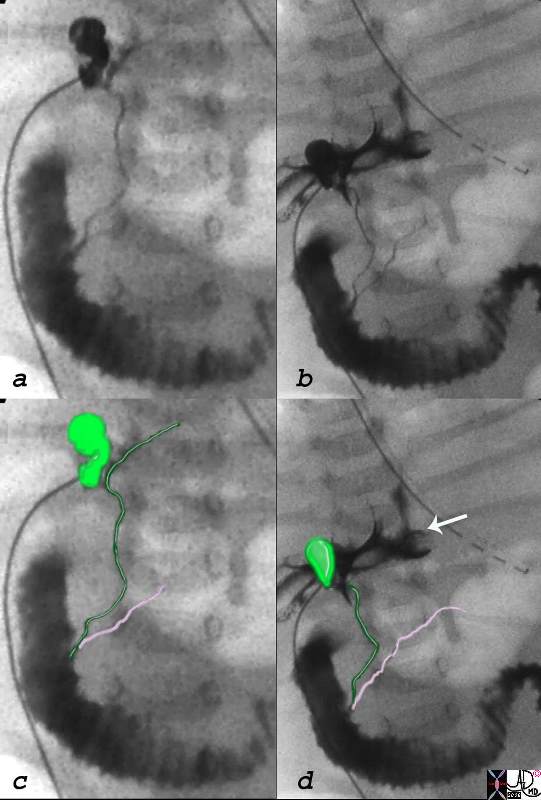The Common Vein Copyright 2008
Definition
Biliary atresia is a growth abnormality of the biliary system that is charcterized by poor development of parts of the biliary system that presents in the newborn period with jaundice.
Two forms are present;
postnatal form called isolated biliary atresia (65-90%) which appears to be a disease caused by toxins or an infection that results in inflammation.
fetal/embryonic form which is a congenital abnormality that is associated with other congenital aberrations.
Structurally three forms are recognized
Type I – Obliteration of the common duct
Type II – Atresia of the hepatic duct and cystic structures in the porta
Type III Atresia of the left and right ducts (>90%)
Functionally there is failure of delivery of bile to the gallbladder and or the duodenum. Bile production by the liver is normal.
The diagnosis is considered clinically in infants who present between 2 and 8 weeks post natally with neonatal cholestasis characterized by jaundice, dark urine, and light stools. Hepatosplenomegaly is usually present.
The diagnosis of obstructive jaundice is confirmed by identifying elevated direct hyperbilirubinemia, and alkaline phosphatase.
Imaging studies include ultrasound which may show an absent gallbladder, hepatobiliary radioisotopic imaging, and ERCP.
The most valuable diagnostic study is a liver biopsy. Intraoperative cholangiography is performed when diagnosis remains equivocal.
Treatment is surgical with Kasai procedure consiting of a portoenterostomy is performed. Sometimes a gallbladder to smallbowel anastamosis is performed (modified Kasai) . In the inflammatory form, steroids are used to act as an antiinflammatory agent. If the extrahepatic ducts are obliterated then liver transplantation is necessary
In the congenital form other diseases such as polysplenia and asplenia syndromes coexist, and these are characterized by situs inversus and situs ambiguus – entities that have associated extensive anatomical congenital abnormalities including cardiac malformations. These structural abnormalities are easily recognised by imaging,are easily recognised by imaging.

Biliary Atresia and Hypoplastic Gallbladder |
| This percutaneous cholangiogram was performed on a neonate with profound jaundice. A catheter enters the gallbladder directly (seen to the left of images (a,b,c,d) and injection shows filling of a small gallbladder (light green in c,d) and part of the left duct and all the CBD (dark green) and pancreatic duct. (pink) In an attempt to fill the intrahepatic radicles, continued injection caused contrast to spill into the subhepatic space (arrow, d). The absence of filling of the intrahepatic radicles is reminiscent of type III biliary atresia. The gallbladder is small and hypoplastic.
28814c02.8s gallbladder small absent hypoplastic intrahepatic bile ducts liver biliary atresia congenital cholangiogram Courtesy Ashley Davidoff MD copyright 2008 |
References
Brookes Clinical Embryology: A Color Atlas and Text By Murray Brookes, Anthony Zietman Published by CRC Press, 1998
Meilstrup JW Imaging Atlas of the Normal Gallbladder and Its Variants By Jon W. Meilstrup Published by CRC Press, 1994
Schwarz Steven M Schwarz, MD, Biliary Atresia eMedicine 2007
